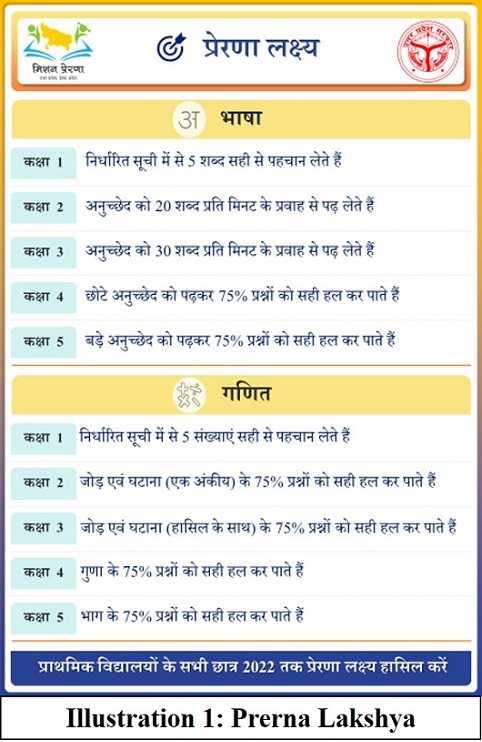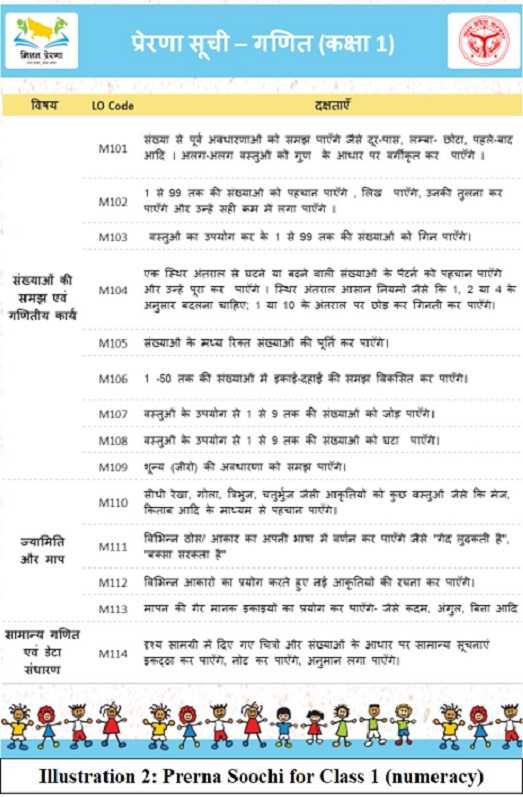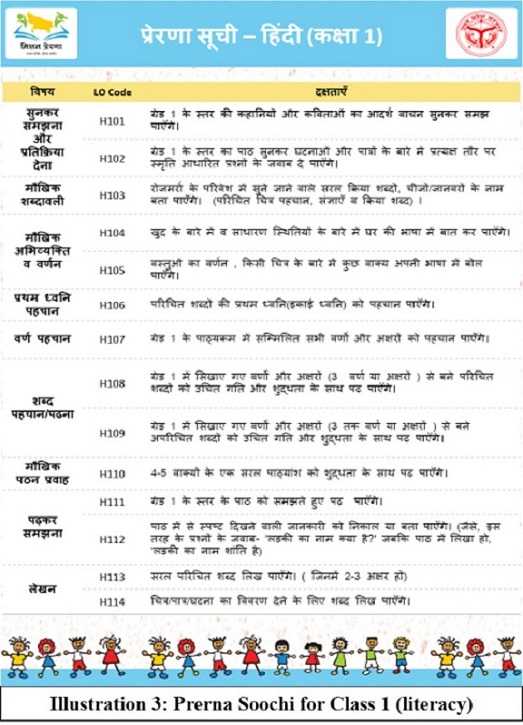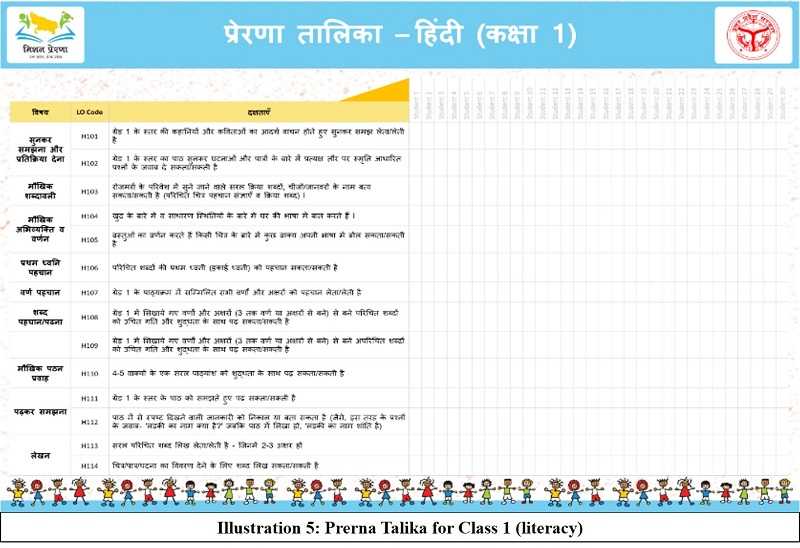According to the Annual Status of Education Report (ASER) 2019 more than 90% of children in the age group 4-8 are enrolled in some type of educational institution, these include pre-schools (Anganwadis, LKG or UKG classes) or schools (government or private). At the same time the report highlights that 39% students in grade 1 cannot identify or read letters, 45.8% students in grade 2 can only identify and read letters but cannot read whole words, and only 50% students in grade 3 can even read a grade 1-level text. It also mentions that, 26.9% students in grade 1 cannot identify and count numbers between 1-9, 38.7% students in grade 2 and 27.8% in grade 3 cannot identify and count numbers above 9 (i.e., 10-99).
Given this context, it is clear that while successive governments have been able to ensure the physical presence of students inside classrooms, this hasn’t necessarily ensured adequate learning inside them. The statistics highlighted above are measured against specific skills such as the skill of reading and identifying letters or the skill of identifying numbers. These skills comprise what is called foundational literacy and numeracy (FLN) skills. Foundational literacy would include reading and comprehension skills such as identifying letters, reading of non-words, oral reading fluency, listening with comprehension etc. Foundational literacy in numeracy would include skills related to ‘number sense’ such as identification of numbers, finding missing numbers, solving addition and subtraction problems among other things. These skills form the basis for all future learning that the child then undertakes. It is as a consequence of students failing to acquire these FLN skills during the initial years of schooling, that the learning crisis in classrooms takes root, as the gap between what a student is taught and what she can comprehend steadily widens.
Policy response to foundational learning
The recently released National Education Policy (NEP) 2020 by the Ministry of Education, Government of India draws an outline for the country to achieve FLN skills. It states that the "…highest priority of the education system will be to achieve universal foundational literacy and numeracy in primary school by 2025". It calls for a national mission around attainment of FLN skills to be set up by the Ministry with clearly determined short-term goals. The policy amongst other things highlights competencies important for both literacy and numeracy, urges states to ensure ideal pupil to teacher ratio (25:1), increase access to early childhood care and education, get local community to commit to education. While all the listed focus areas merit attention, strictly from an academic standpoint to transform a classroom, 3 areas listed in the NEP particularly become important:
- Curriculum focus on FLN skills: Increasing focus on foundational literacy and numeracy inside the classrooms with emphasis on reading, writing and numeracy. This will be supplemented by continuous formative/adaptive assessments to track individual progress.
- Teacher training on FLN skills: A shift in teaching pedagogy would require teachers to be trained and supported to through continuous professional development and training.
- Introduction of supplementary reading material: Interesting and inspirational text to be made available for students in local and other Indian languages to provide enough material for students to build reading and comprehension abilities.
Even as different states strategize on how to achieve foundational literacy for their students, one state is already paving the way by implementing several FLN-focused reforms for its government schools.
‘Uttar Pradesh, Prerak Pradesh’
Setting an ambitious goal
In September 2019, the Chief Minister of Uttar Pradesh, Yogi Adityanath, launched Mission Prerna with the singular objective of ensuring that the state’s 1.2 crore primary school students in government schools achieve foundational learning skills by 2022. The state government has set quantifiable goals for classes 1-5 to be achieved by more than 1.5 lakh schools. These goals for literacy and numeracy are listed in a document called the ‘Prerna Lakshya’ (Illustration 1). The relevance and importance of this document is recognized by education department officials and teachers alike in the state. A third-party will assess the performance of students against this goal periodically. Successful attainment of the Lakshya would mean that the child has acquired all learning outcomes listed in the overall outcome framework.
Developing a learning outcomes framework to enable goal attainment
To ensure that instruction inside classrooms is completely focused on foundational learning skills, a new learning outcome framework for literacy and numeracy has been devised for grades 1-5. This learning outcome framework is called the ‘Prerna Soochi’. It consists of learning outcomes related to foundational learning skills in literacy and numeracy that the child needs to be taught in each grade. These outcomes, which range between 14-16 for each subject and each grade, have been made concise and ‘skill driven’ to ensure clarity for teachers (Illustrations 2 and 3). The most critical outcome from this list of 14-16 outcomes makes up the Prerna Lakshya.
To make the ‘Prerna Soochi’ completely suitable to the needs of classrooms in UP, the process of deciding each learning outcome was deeply consultative and immersive. A comprehensive analysis and mapping of Early Grade Reading Assessment (EGRA) and Early Grade Mathematics Assessment frameworks, NCERT and SCERT (Uttar Pradesh) outcomes framework for literacy and numeracy was conducted. In addition to this the diversity of stakeholders involved in development—SSA (Samagra Shiksha Abhiyan), SCERT, Language and Learning Foundation, Vikramshila, Central Square Foundation and the academic core group (comprising experienced school teachers from UP), ensured that the framework was comprehensive and struck a balance between aspirational and essential learning targets.
Helping teachers adapt to learning outcomes-based teaching
It is imperative to ensure the understanding and comfort of teachers with this new academic design to make the teaching-learning process inside the classroom effective. For this purpose, six ‘Adharshila Kriyanvan Sandarshika’ (foundational learning implementation guides) have been developed for grades 1-3 for both literacy and numeracy. The implementation guides are prescriptive documents developed basis the ‘Prerna Soochi’, relevant for each subject and grade. They provide clarity on teaching FLN skills by mapping learning outcomes across an annual calendar. They also provide prescriptive lesson plans broken down to the level of activities and corresponding resources required to attain learning outcomes. The state is also providing high quality, FLN-focused resources including print rich material—posters and charts for literacy and numeracy, books customised for UP and an 11-item math kit to all primary schools, to make the class resource rich. All of these items have been referenced in the implementation guides, explaining their use during activities and instruction. This ensures that at any point while teaching, the teacher will have absolute clarity on ‘what needs to be taught when’ and ‘what materials need to be leveraged’.
Teachers are also being trained on this new academic design through a video-based (part 1/4) training series that captures the essence of the new model of classroom teaching. In addition to this, one round of training for over 5,00,000 primary teachers on key foundational learning concepts in literacy and numeracy has also been completed, leveraging online platforms such as DIKSHA and conducting meetings in smaller groups using Hangouts, WhatsApp video calls etc. These trainings were conducted by Academic Resource Persons (ARPs). ARPs are a 4,400 strong mentoring cadre of selected teachers operating at the block level. They themselves were trained for conducting this training by State Institute of Educational Management and Training (SIEMAT), Uttar Pradesh.
Tracking outcomes achievement inside the classroom
As the focus shifts to learning outcomes-based teaching inside the classroom, a child’s progress will have to be recorded and assessed along the same lines. Therefore, to ensure that the teachers record progress made by each child against the desired learning outcomes, a ‘Prerna Talika’, a spreadsheet of names of students inside the classroom listed against learning outcomes has also been developed (Illustrations 4 and 5). Along with the ‘Prerna Lakshya’ and ‘Prerna Soochi’, the ‘Prerna Talika’ is also being pasted in all classrooms to ensure the achievement of milestones’ gets celebrated, recorded and monitored.
Conclusion
With the spotlight in the national education narrative turning to FLN skills, it is only a matter of time before all states in the country realign their priorities towards achieving foundational literacy for their students. Uttar Pradesh’s experience implementing FLN-focused reforms could serve as a useful starting point for other states embarking upon their own FLN journeys.





